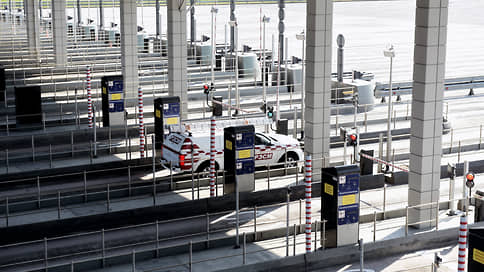“Kommersant” found out how much Russians’ interest in toll roads has grown
[ad_1]

In 2023, more than 278 million vehicle passages were recorded on Avtodor toll sections, 17.9% more than a year earlier. At the same time, the head section of the M-11 highway from Moscow to Solnechnogorsk, one of the most expensive for drivers in Russia, showed a 30 percent increase in traffic. On the Western High-Speed Diameter in St. Petersburg in 2023, a record annual traffic was set for all 12 years of operation of the route. Despite high tariffs, motorists are getting used to toll roads and using them more and more every year, experts say.
According to Avtodor data (provided at the request of Kommersant), in 2023, 278.7 million trips were recorded on all toll sections of the state company, which is 17.9% more than a year earlier. In 2022, the increase was 13.3%. The main reasons for the growth in Avtodor are the introduction of new toll sections on M-4 (Aksai and Krasnodar bypasses in June), on M-12 (Moscow-Arzamas in September, Shumerlya-Innopolis in November and other sections to Kazan in December). The highest daily traffic was recorded on August 12 and 19 at the toll point on the 71st km of the M-4 in the Moscow region (about 80 thousand passages), on August 20 – at the 46th km of the M-1 highway (58 thousand), 24 September – on the Moscow-Elektrougli M-12 section (42.1 thousand), December 30 – along the entire M-12 (91.2 thousand).
The North-Western Concession Company (NWCC; concessionaire of the 15–58th km section of the M-11 Neva) spoke about “record traffic” since the opening of the road in 2014: on weekends in the summer of 2023, more than 100 people drove along the highway thousand cars per day, and in just one year more than 22.5 million vehicles traveled on the road, 30% more than the year before. In 2022, let us remind you that the dynamics on this route were negative – minus 14% (compared to 2021). “The growth in traffic is explained by the development of domestic tourism and the increase in the number of summer residents,” they say in the NWCC. “The expansion of the network of toll roads throughout the country makes it more convenient to use them for long trips. This is due to the increase in transit cargo flow from St. Petersburg in the direction of the Central Ring Road and in the opposite direction.”
On the Western High-Speed Diameter in St. Petersburg (WHSD; concessionaire – Northern Capital Highway company) in 2023, 105.6 million transactions were recorded, or 71.3 million trips (3.2% more than in 2022) . This is a record annual traffic for all 12 years of operation of the route. “In the absence of significant changes in infrastructure, we are observing a continuing evolutionary growth in the number of users,” explained Elena Lukyanova, general director of Northern Capital Highway LLC. “Tariff changes (prices for the WHSD have changed twice over the past year.— “Kommersant”) did not actually affect the dynamics of traffic flow. We continue to see high demand for the highway.” The company recorded its maximum daily traffic and revenue on May 12, 2023, although in previous years the record was most often recorded on the first Friday of September. The company also noticed an increase in the popularity of various tariff options (the ability to purchase a discount for a fixed fee): “We attribute this to the increasing frequency of use of the highway by regular customers and the desire to optimize their costs.”
On the Northern Bypass of Odintsovo, more than 26 million vehicle passages were recorded in 2023, which is 7% more than in 2022, Kommersant was told by the company “New Quality of Roads” (the operator of the route). The company mentioned the opening in September of the toll Bagration Avenue, which connects Moscow City and the Moscow Ring Road: in four months, more than 2.5 million trips were recorded along the highway.
An increase in traffic on Avtodor roads was expected due to the commissioning of several large sections, says Petr Shkumatov, coordinator of the Blue Buckets movement. He also recalls that in 2023, airports were closed in the south of the country, and therefore more people than usual traveled along the M-4 by car. Avtodor, responding to a request from Kommersant, also noted an “increased” demand for seasonal trips by car users during the holiday season along the M-4, but did not provide exact figures.
According to Rosstat, domestic tourism has grown by more than 16% in nine months, says Ksenia Rostislav, a researcher at the Laboratory of Infrastructure and Spatial Research at the Institute of Economics and Public Administration of the Russian Presidential Academy of National Economy and Public Administration. “Many people used toll roads because it was faster and more convenient, despite being somewhat expensive,” the expert believes. “There is also an addiction factor. At first, paying for travel was unusual and strange, but now it is taken for granted, as a payment for comfort and speed.” “Our motorists are gradually getting used to toll roads, despite the very high tariffs,” agrees the editor-in-chief of the Za Rulem magazine, Maxim Kadakov. “This is a little scary, which means there will be even more toll roads in Russia.”
In 2024, Avtodor will complete and open traffic on the Tver bypass as part of the M-11, complete the improvement of the M-4 in the Voronezh and Rostov regions (with the introduction of a toll), complete the interchange of the Central Ring Road with the Mozhaisk Highway in the Malye Vyazem area, as well as the Dyurtyuli section —Achit as part of the M-12, which will pass through the territory of Bashkiria, the Perm Territory and the Sverdlovsk Region. The Moscow region plans to launch traffic on the toll Mytishchi Expressway and the Yuzhno-Lytkarinskaya Road this year.
[ad_2]
Source link








